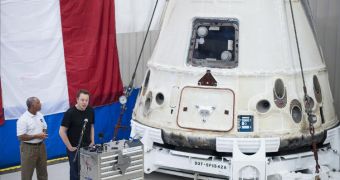Officials at Hawthorne, California-based Space Exploration Technologies Corporation (SpaceX) are pleased to announce that the American space agency has formally given its seal of approval for the launch of 12 robotic resupply missions to the International Space Station (ISS).
Until now, the company worked under a Commercial Orbital Transportation Services (COTS) contract worth some $400 million. With the completion of a space docking in low-Earth orbit earlier this year, SpaceX met all the requirements stipulated in the agreement.
On May 25, the unmanned version of the SpaceX Dragon spacecraft docked to the nadir port on the US-built Harmony module, aboard the ISS, following a successful May 22 launch aboard the Falcon 9 delivery system. The latter was also built and designed by the Californian company.
The flight actually combined two milestones originally meant to be treated in separate missions. The first was flying the Dragon capsule in its complete configuration, while the second involved conducting the first rendezvous and orbital docking maneuvers.
Since these capabilities have been demonstrated, SpaceX has now been approved to move on to the next phase of its collaboration with NASA, which involves conducting 12 resupply flights to the ISS over the next few years.
From now on, SpaceX will no longer operate under the terms of the $400 million COTS contract, but under those of a $1.6 billion Commercial Resupply Services (CRS) agreement it signed with the American space agency on December 23, 2008.
The first CRS, non-demo mission is scheduled to launch to the ISS this October, and is codenamed CRS SpX-1. A second light, codenamed CRS SpX-2, is scheduled for December. The exact launch dates have yet to be revealed.
In addition to SpaceX, several other companies are working under the COTS program. The most advanced of this group is Virginia-based Orbital Sciences Corporation, which is developing the Antares rocket and Cygnus spacecraft combo under a $1.9 billion contract with NASA.
By the end of the year, Orbital plans to conduct two test missions with its vehicles. The first will be Antares' maiden flight, sometimes beyond October 5, and the second will be Cygnus' maiden flight, scheduled for December, Space reports.

 14 DAY TRIAL //
14 DAY TRIAL //